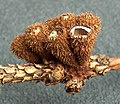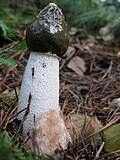Belly fungus
The division of living beings into systematics is a continuous subject of research. Different systematic classifications exist side by side and one after the other. The taxon treated here has become obsolete due to new research or is not part of the group systematics presented in the German-language Wikipedia.
The belly mushrooms (Gastromycetes or Gasteromycetes) represent an obsolete form taxon in the realm of mushrooms , since the polyphyletic origin of the assigned groups has meanwhile been proven. The associated taxa are systematically assigned to the mushrooms (Basidiomycota). Belly mushrooms are characterized by the fact that the basidiospores are formed inside the fruiting body. The part carrying the spores , actually a gasteroid basidiocarp, is called the gasterothecium in the case of the belly mushrooms .
Belly mushrooms are traditionally one of the following species:
- Order: agaric mushrooms (Agaricales)
- Family: Earth star relatives (Geastraceae)
- Genus: Earth stars ( Geastrum )
- Family: Mushroom relatives (Agaricaceae) - formerly nestling relatives (Nidulariaceae)
- Genus: Nestlings ( Nidularia )
- Genus: Expensivelings ( Cyathus )
- Genus: crucibulum ( Crucibulum )
- Genus: Kugelschneller ( Sphaerobolus )
- Genus: dwarf nest mushrooms ( Mycocalia )
- Family: Stäublingsverwandte (Lycoperdaceae)
- Genus: Boviste ( Bovista )
- Genus: Large Dusters ( Calvatia )
- Genus: Spaltporenstäublinge ( Handkea )
- Genus: puffballs ( Lycoperdon )
- Genus: Meadow pustules ( Vascellum )
- Family: Earth star relatives (Geastraceae)
- Order: Stinkhorn-like (Phallales)
- Family: Rod mushroom relatives (Phallaceae)
- Genus: Stinkhorn ( Phallus )
- Genus: lattice lattices , squid mushrooms ( Clathrus ) formerly kept in a separate family lattice relatives (Clathraceae)
- Family: Rod mushroom relatives (Phallaceae)
- Order boletales (Boletales)
- Family: Hartbovist relatives (Sclerodermataceae)
- Genus: Hard bovine , potato bovine ( Scleroderma )
- Family: Hartbovist relatives (Sclerodermataceae)
A very similar way of life to the basidiocarpic belly mushrooms also have the truffles ( Tuber ), but they belong to the Ascomycota mushrooms . Their spore carriers are accordingly called tuberothecia .




